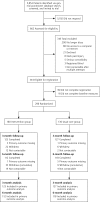Internet-Based Vestibular Rehabilitation for Older Adults With Chronic Dizziness: A Randomized Controlled Trial in Primary Care
- PMID: 28483885
- PMCID: PMC5422081
- DOI: 10.1370/afm.2070
Internet-Based Vestibular Rehabilitation for Older Adults With Chronic Dizziness: A Randomized Controlled Trial in Primary Care
Abstract
Purpose: Vestibular rehabilitation is an effective intervention for dizziness due to vestibular dysfunction, but is seldom provided. We aimed to determine the effectiveness of an Internet-based vestibular rehabilitation program for older adults experiencing dizziness in primary care.
Methods: We undertook a single-center, single-blind randomized controlled trial comparing an Internet-based vestibular rehabilitation intervention (Balance Retraining, freely available from https://balance.lifeguidehealth.org) with usual primary care in patients from 54 primary care practices in southern England. Patients aged 50 years and older with current dizziness exacerbated by head movements were enrolled. Those in the intervention group accessed an automated Internet-based program that taught vestibular rehabilitation exercises and suggested cognitive behavioral management strategies. Dizziness was measured by the Vertigo Symptom Scale-Short Form (VSS-SF) at baseline, 3 months, and 6 months. The primary outcome was VSS-SF score at 6 months.
Results: A total of 296 patients were randomized in the trial; 66% were female, and the median age was 67 years. The VSS-SF was completed by 250 patients (84%) at 3 months and 230 patients (78%) at 6 months. Compared with the usual care group, the Internet-based vestibular rehabilitation group had less dizziness on the VSS-SF at 3 months (difference, 2.75 points; 95% CI, 1.39-4.12; P <.001) and at 6 months (difference, 2.26 points; 95% CI, 0.39-4.12; P = .02, respectively). Dizziness-related disability was also lower in the Internet-based vestibular rehabilitation group at 3 months (difference, 6.15 points; 95% CI, 2.81-9.49; P <.001) and 6 months (difference, 5.58 points; 95% CI, 1.19-10.0; P = .01).
Conclusions: Internet-based vestibular rehabilitation reduces dizziness and dizziness-related disability in older primary care patients without requiring clinical support. This intervention has potential for wide application in community settings.
Keywords: Meniere disease; behavioral medicine; chronic care; ear, nose, and throat (ENT); practice-based research; primary care; vertigo.
© 2017 Annals of Family Medicine, Inc.
References
-
- Sloane P, Blazer D, George LK. Dizziness in a community elderly population. J Am Geriatr Soc. 1989;37(2):101–108. - PubMed
-
- Gans RE. Vestibular rehabilitation: critical decision analysis. Semin Hear. 2002;23(2):149–159.
-
- Yardley L, Donovan-Hall M, Smith HE, Walsh BM, Mullee M, Bronstein AM. Effectiveness of primary care-based vestibular rehabilitation for chronic dizziness. Ann Intern Med. 2004;141(8):598–605. - PubMed
-
- Friedman SM, Munoz B, West SK, Rubin GS, Fried LP. Falls and fear of falling: which comes first? A longitudinal prediction model suggests strategies for primary and secondary prevention. J Am Geriatr Soc. 2002;50(8):1329–1335. - PubMed
Publication types
MeSH terms
Grants and funding
LinkOut - more resources
Full Text Sources
Other Literature Sources
Medical
Research Materials
Miscellaneous

